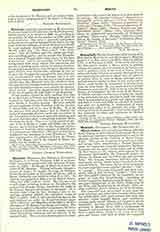

Mazzolini , LODOVICO (also known as MASSOLINI DA FERRARA, LODOVICO FERRARESA, and IL FERRARESE), Italian painter, b. in Ferrara in 1480; d., according to one account, in 1528, and to another, in 1530; place of death unknown. This artist is generally represented as having been a pupil of Lorenzo Costa, and as having come under the influence of Ercole Roberti, but should be more correctly described as a pupil of Panetti. Morelli called him “the Glow-worm”, “der Gluhwurm”, from his brilliant gem-like color and luminous sparkling quality, and he proved that Mazzolini was a pupil of Panetti rather than Costa, by the form of the ear an, and in his paintings, by his landscape backgrounds with steep conical blue mountains and streaks of dazzling white, and by his scheme of color. Comparing Lorenzo Costa with Perugino, Morelli compares Panetti with Pintorrichio, although he says as an artist the Perugian far surpassed the somewhat dry and narrow-minded artist of Ferrara, but it is perfectly clear that it was to this dry and so-called narrow-minded man that Mazzolini owed his excellent work. The architectural backgrounds of his pictures are their specially distinctive feature, and notably the creamy-toned marble. Attention should further be directed to his use of gold in the high lights of his draperies.
Of his personal history we know nothing, save that he worked both in Ferrara and Bologna, and that he married in 1521 Giovanna, the daughter of Bartolomeo Vacchi, a Venetian painter. His most notable picture represents Christ disputing with the doctors, is dated 1524, and to be seen at Berlin. It is in his pictures with small figures that he displays the power of imparting pleasure, as his gift was rather in the direction of genre than of historical painting, and to most observers there is something curiously Flemish about his work. There is a second important picture of his in Berlin, a Virgin and Child, two at the Louvre, one in Ferrara, three in the National Gallery, and three in Florence, other examples in Munich, and in various private collections. The chief work of his in England is one belonging to Lord Wimborne. He is also represented in the galleries of Turin, St. Petersburg, The Hague, and in the Capitol at Rome, the Doria, and the Borghese.
GEORGE CHARLES WILLIAMSON

